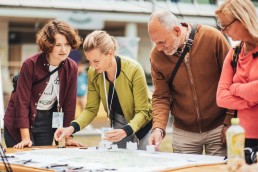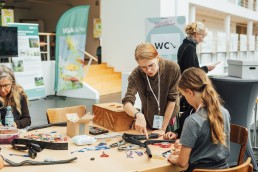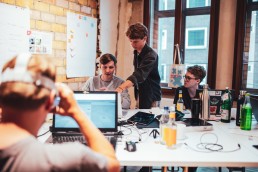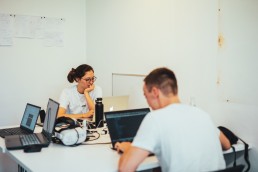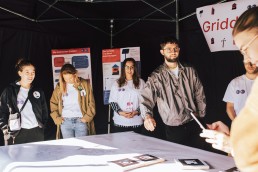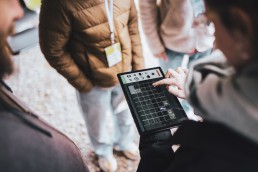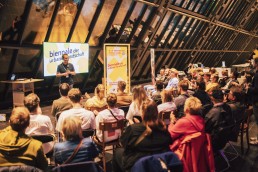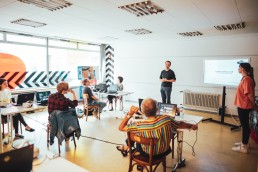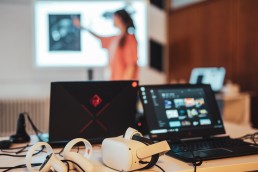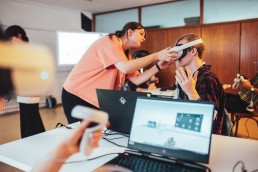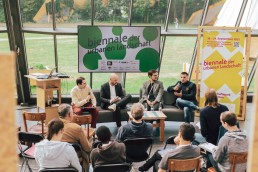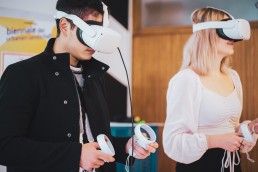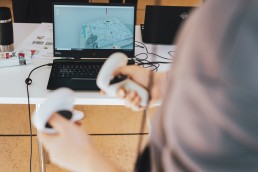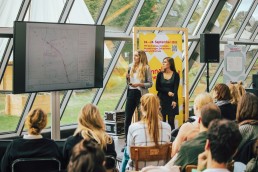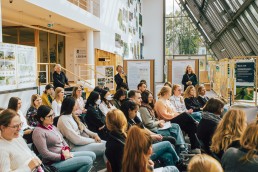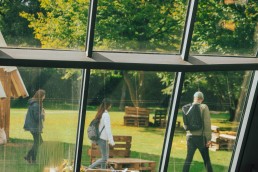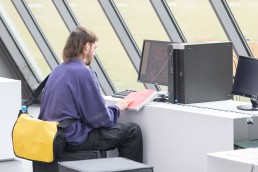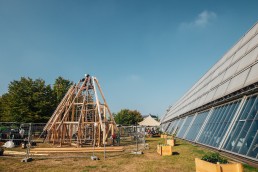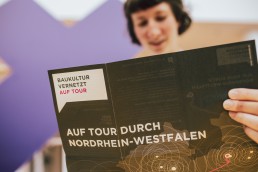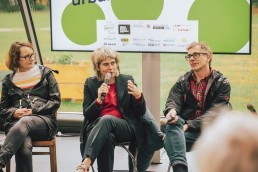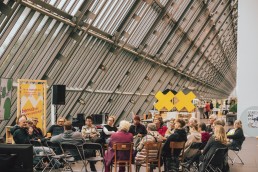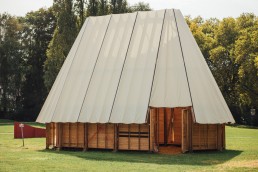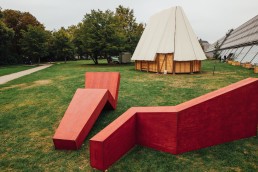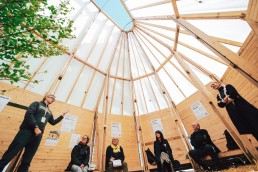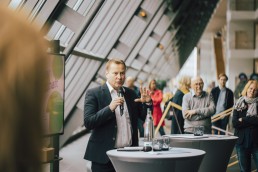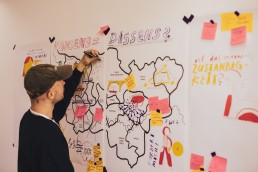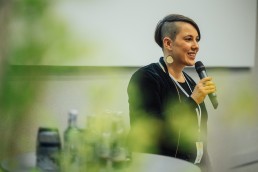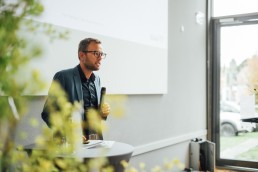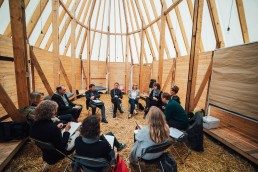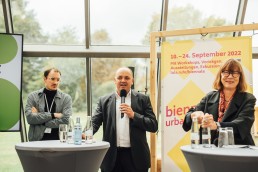
10. – 24. september 2022
gelsenkirchen / metropole ruhr
10. – 24. september 2022
gelsenkirchen / metropole ruhr
review
The 1st Biennale of Urban Landscape sets new standards
From September 10-24, 2022, the first Biennale of Urban Landscape attracted grassroots initiatives as well as the big players in planning. lala.ruhr had invited motivated people from all disciplines to this festival. 204 participants responded to the call and together they staged over 130 events in and around the Science Park in Gelsenkirchen.
On this website we document the program, the exchange and the results of this eventful and intensive 1st biennial of urban landscape in the Ruhr Metropolis.
The event-magazine
A 40-page magazine has been published to accompany the 1st Biennale of the Urban Landscape, showcasing the colorful diversity of actors involved in shaping the “city of tomorrow.” Included are local and international thought leaders who share innovative thoughts and insights from their work. In sections such as “Portrait” and “Lab,” initiatives, associations and best-practice examples are presented. A glossary brings clarity to current key terms and buzzwords surrounding the urban landscape, and “Facts, Figures,” sheds light on the question “How green is the industrial region?” Photos from the “Mapping the City” exhibition and a slam poetry text give a taste of how the urban landscape is reflected on an artistic level in words and images. The texts in the magazine are mixed in German and English.

Whoever says "green" should also say "colorful"
The regional, supraregional and also international powerhouse of grassroots initiatives, planners, scientists and artists in commitment to the green city of the future presented the Weekend of Diversity. The question of how we can shape the Ruhr as a livable region stimulated numerous debates, which were conducted with seriousness and openness, with visionary power and a sense of reality at workshops, lectures, discussions and participatory activities.

Hackathon in Residence
This hackathon lasted a full seven days and involved living and working on site. In total, 20 young professionals and students from all over Europe – including the Netherlands, the UK, Slovenia and France – worked together. Their expertise ranged from 3D animation, game design, photography and VR programming to urban planning, landscape architecture and data analysis. The tasks were complex and required intensive collaboration under high time pressure. In four teams, the residencies dealt with problematic places and areas in Gelsenkirchen-Ückendorf concretely and directly on the doorstep. Brownfields, heat islands and a street canyon like those in other cities were given their digital transformation.
Trips into the digital
A game designer and an urban planner meet – what starts as a joke was the basis of one of the workshops in the “Digital Realities Week”. Together, the participants found out whether and how 3D game engines help planners to simulate climate-resilient buildings and places. Other workshops were held on “Augmented Reality in Urban Planning” and “Designing and Building in Virtual Reality”.
During excursions into virtual reality, beginners were able to take their first steps and advanced users were able to gain new insights into VR. The program included excursions to the Metaverse and learning about planning and simulation tools.
A highlight at the end of the week on 16 & 17 September was the lecture program with panels, deep dives and impulse lectures. The program topics cover e.g. “Digital Twins”, smart sensor technology in the beehive, participation via augmented and virtual reality and the possibilities of sustainable and energy-saving AI.

Visions of students
The motto “Design for Urban Uncertainties” challenged the young international representatives from TU Dortmund, TH Ostwestfalen-Lippe and RWTH Aachen University. While some of the interdisciplinary teams came up with concrete ideas for improving the local district, others took a look at the entire Ruhr Metropolis and sketched out scenarios for how the former industrial region can become an energy region. The range of ideas, visions and contributions was huge. They were all relevant; they all made it clear on how many levels there is a need for action.
Future needs building culture
Baukultur NRW was involved in the first Biennale of the Urban Landscape with a variety of program items and encouraged people to think about the design of urban spaces and the integration of the important functions of greenery. The temporary urban development pavilion “a-circus” clearly symbolized the transformative forces of the urban landscape.


A convention as the conclusion
The convention “Design for urban uncertainties” formed the closing weekend of the Biennale on September 23 and 24 – an international weekend of competencies, frameworks, solutions and visions.
Experts from different disciplines discussed green strategies and real solutions from a global and local perspective. They looked back on the past successes and visions of the Ruhr region, reflected on the current projects of the Ruhr Conference and talked about the landscape as a basis of urban and regional future.
Speakers at the convention included landscape architect Dr. Carlo Becker, Anja Bierwirth (Wuppertal Institute), State Secretary Viktor Haase (Ministry for the Environment, Nature Conservation and Transport of North Rhine-Westphalia), Parliamentary State Secretary Josef Hovenjürgen (Ministry for Home Affairs, Municipal Affairs, Building and Digitalization of North Rhine-Westphalia), Prof. Dr. Sanda Lenzholzer (Wageningen University), Reiner Nagel (Bundesstiftung Baukultur), dr.sc. ETH Haris Piplas (Co-Director Integrated Urban Solutions, Drees & Sommer International), Univ.-Prof. Christa Reicher from RWTH Aachen University and Holger Robrecht and Daniela Rizzi (ICLEI Europe).
We could only do that together
lala.ruhr are Melanie and Sebastian. But we never work alone. So far we have worked on projects with Isabella, Annette, Jan, Sonja, Matthias, Juliane, Sally, Roman, Stephanie, Petra, Martina, Nadja and Johannes. Here you can learn more about us: The team
For the first Biennial of Urban Landscape, many more people joined and we were able to get the following organizations as official partners:

Förderer:



Kooperationspartner:
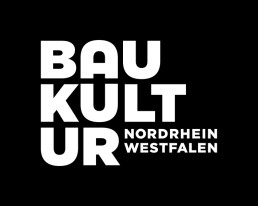
Many other people, companies and institutions participated, for example: Architects4Future Ruhr , Biological Station West Ruhrarea, Cityscaper Aachen, the Royal Danish Embassy, the Stadtretter, the Urbanisten, Emschergenossenschaft, Futur2k, Gemeinsam für Stadtwandel Essen, herdenintelligenz, Impact Factory, Jugend-Architektur-Stadt, kitev – Kultur im Turm, Kunstakademie Düsseldorf, MVRDV, Paper Planes, RWTH Aachen, Technische Hochschule Ostwestfalen-Lippe, TU Dortmund, Urbane Liga, Urbane Künste Ruhr …





Fotos: lala.ruhr | Medienmalocher Ravi Sejk | Ole Kristian Heyer












